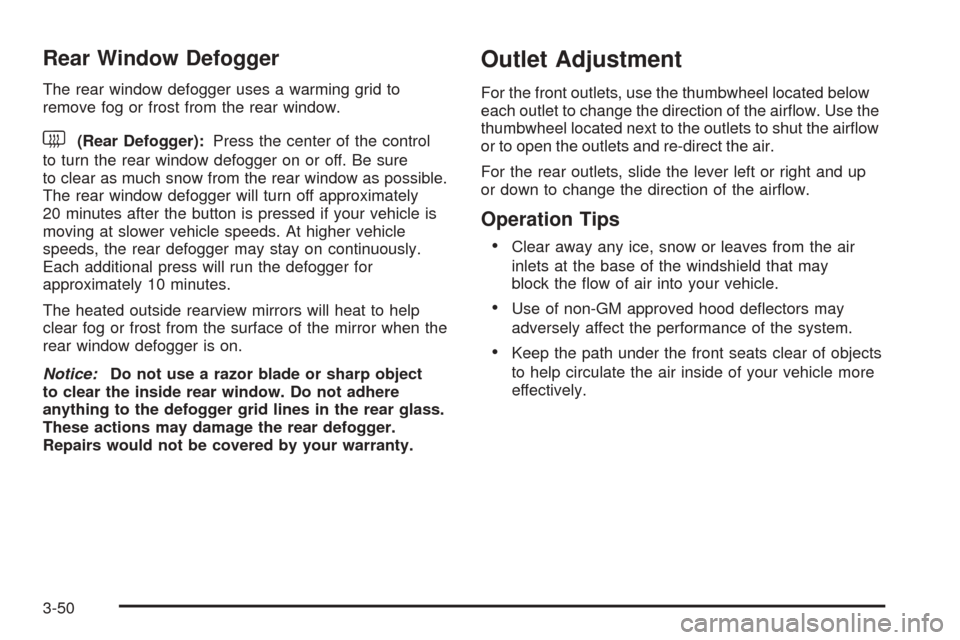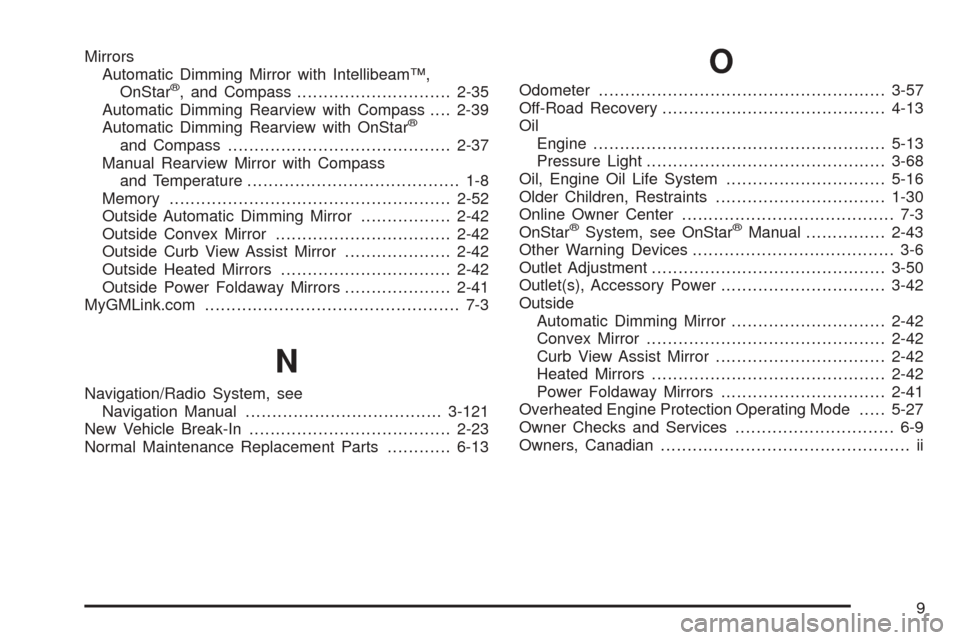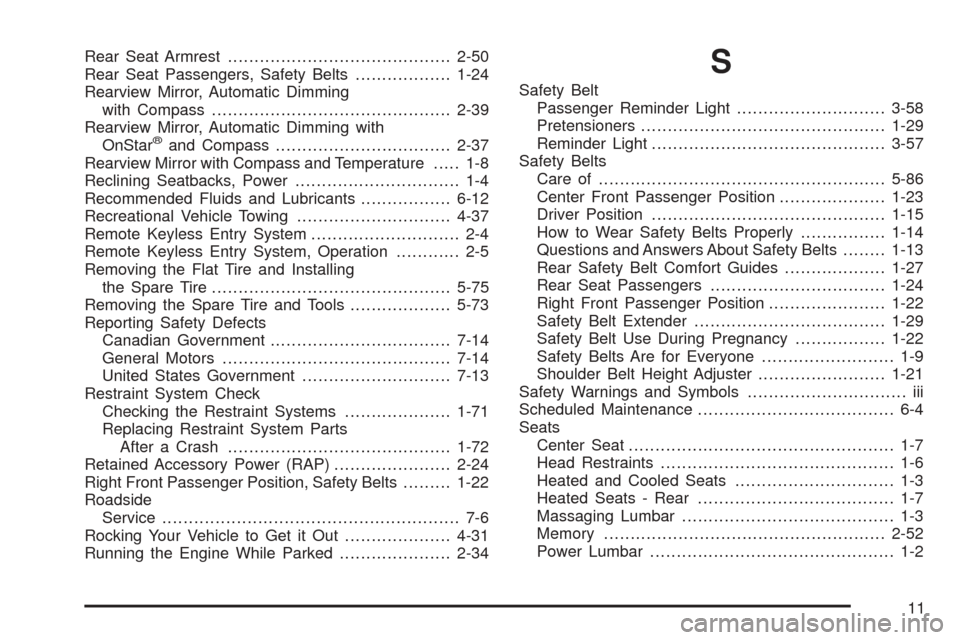rear view mirror CADILLAC DTS PROFESSIONAL 2006 1.G User Guide
[x] Cancel search | Manufacturer: CADILLAC, Model Year: 2006, Model line: DTS PROFESSIONAL, Model: CADILLAC DTS PROFESSIONAL 2006 1.GPages: 450, PDF Size: 2.55 MB
Page 164 of 450

Driving with IntelliBeam™
IntelliBeam™ will only activate your high-beams when
driving over 20 mph (32 km/h).
The high-beam headlamps will remain on, under the
automatic control of IntelliBeam™, until any of the
following situations occur:
The system detects an approaching vehicle’s
headlamps.
The system detects a preceding vehicle’s taillamps.
The outside light is bright enough that high-beam
headlamps are not required.
The vehicle’s speed drops below 15 mph (24 km/h).
The headlamp stalk is moved forward to the
high-beam position or the �ash-to-pass feature is
used. SeeHeadlamp High/Low-Beam Changer
on page 3-9andFlash-to-Pass on page 3-13.
When either of these conditions occur, the
IntelliBeam™ feature will be disabled and the
IntelliBeam™ light in the mirror will turn off until the
high-beam stalk is returned to the neutral position.
If IntelliBeam™ was using low-beams prior to this
action, the IntelliBeam™ feature will be temporarily
disabled until the stalk is returned to the neutral
position.
The exterior lamp control is turned to any setting
except AUTO.
When this occurs, IntelliBeam™ will be disabled
until the control is turned back to the AUTO position.
The IntelliBeam™ system is turned off at the inside
rearview mirror.
IntelliBeam™ may not turn off the high-beams if the
system cannot detect other vehicle’s lamps because of
any of the following:
The others vehicle’s lamp(s) are missing, damaged,
obstructed from view or otherwise undetected.
The other vehicle’s lamp(s) are covered with dirt,
snow and/or road spray.
The other vehicle’s lamp(s) cannot be detected due
to dense exhaust, smoke, fog, snow, road spray,
mist or other airborne obstructions.
Your vehicle’s windshield is dirty, cracked or
obstructed by something that blocks the view of
the IntelliBeam light sensor.
Your vehicle’s windshield is covered with ice, dirt,
haze or other obstructions.
3-32
Page 165 of 450

Your vehicle is loaded such that the front end of the
vehicle points upward, causing the IntelliBeam
sensor to aim high and not detect headlamps and
taillamps.
You are driving on winding or hilly roads.
You may need to manually disable or cancel the
high-beam headlamps by turning the low-beam
headlamps on, if any of the above conditions exist.
Disabling and Resetting IntelliBeam™
at the Rearview Mirror
IntelliBeam™ can be disabled by using the controls on
the inside rearview mirror.
AUTO
3(On/Off):To disable the system, press this
button on the inside rearview mirror. The IntelliBeam™
indicator will turn off and the will not come back on until
the IntelliBeam™ button is pressed again.
(Stalk Disable):When IntelliBeam™ has turned on the
high-beams, pull or push the high-beam stalk. This
will disable IntelliBeam™. The IntelliBeam™ indicator
on the mirror will turn off. To re-enable IntelliBeam™,
press the IntelliBeam™ button on the mirror.A different sensitivity setting is available for dealer
diagnostics. This is done by pushing and holding this
button for 20 seconds until the IntelliBeam™ indicator
light �ashes three times. If you accidentally activate this,
the vehicle’s setting will automatically be reset each
time the ignition is turned off and then on again.
Cleaning the IntelliBeam™ Light Sensor
The light sensor is located
on the inside of the vehicle
in front of the inside
rearview mirror.
Clean the light sensor window, periodically, using
glass cleaner on a soft cloth. Gently wipe the sensor
window. Do not spray glass cleaner directly on the
surface of the sensor window.
3-33
Page 182 of 450

Rear Window Defogger
The rear window defogger uses a warming grid to
remove fog or frost from the rear window.
<(Rear Defogger):Press the center of the control
to turn the rear window defogger on or off. Be sure
to clear as much snow from the rear window as possible.
The rear window defogger will turn off approximately
20 minutes after the button is pressed if your vehicle is
moving at slower vehicle speeds. At higher vehicle
speeds, the rear defogger may stay on continuously.
Each additional press will run the defogger for
approximately 10 minutes.
The heated outside rearview mirrors will heat to help
clear fog or frost from the surface of the mirror when the
rear window defogger is on.
Notice:Do not use a razor blade or sharp object
to clear the inside rear window. Do not adhere
anything to the defogger grid lines in the rear glass.
These actions may damage the rear defogger.
Repairs would not be covered by your warranty.
Outlet Adjustment
For the front outlets, use the thumbwheel located below
each outlet to change the direction of the air�ow. Use the
thumbwheel located next to the outlets to shut the air�ow
or to open the outlets and re-direct the air.
For the rear outlets, slide the lever left or right and up
or down to change the direction of the air�ow.
Operation Tips
Clear away any ice, snow or leaves from the air
inlets at the base of the windshield that may
block the �ow of air into your vehicle.
Use of non-GM approved hood de�ectors may
adversely affect the performance of the system.
Keep the path under the front seats clear of objects
to help circulate the air inside of your vehicle more
effectively.
3-50
Page 275 of 450

Driving at Night
Night driving is more dangerous than day driving.
One reason is that some drivers are likely to be
impaired — by alcohol or drugs, with night vision
problems, or by fatigue.
Here are some tips on night driving.
Drive defensively.
Do not drink and drive.
Adjust the inside rearview mirror to reduce the glare
from headlamps behind you.
Since you cannot see as well, you may need to
slow down and keep more space between you
and other vehicles.
Slow down, especially on higher speed roads.
Your vehicle’s headlamps can light up only so much
road ahead.
In remote areas, watch for animals.
If you are tired, pull off the road in a safe place
and rest.No one can see as well at night as in the daytime.
But as we get older these differences increase.
A 50-year-old driver may require at least twice as much
light to see the same thing at night as a 20-year-old.
What you do in the daytime can also affect your
night vision. For example, if you spend the day in bright
sunshine you are wise to wear sunglasses. Your
eyes will have less trouble adjusting to night. But if you
are driving, do not wear sunglasses at night. They
may cut down on glare from headlamps, but they also
make a lot of things invisible.
You can be temporarily blinded by approaching
headlamps. It can take a second or two, or even several
seconds, for your eyes to re-adjust to the dark. When
you are faced with severe glare, as from a driver
who does not lower the high beams, or a vehicle with
misaimed headlamps, slow down a little. Avoid
staring directly into the approaching headlamps.
4-17
Page 282 of 450

Highway Hypnosis
Is there actually such a condition as highway hypnosis?
Or is it just plain falling asleep at the wheel? Call it
highway hypnosis, lack of awareness, or whatever.
There is something about an easy stretch of road with
the same scenery, along with the hum of the tires on the
road, the drone of the engine, and the rush of the wind
against the vehicle that can make you sleepy. Do not let
it happen to you! If it does, your vehicle can leave the
road in less than a second, and you could crash and
be injured.
What can you do about highway hypnosis? First, be
aware that it can happen.
Then here are some tips:
Make sure your vehicle is well ventilated, with a
comfortably cool interior.
Keep your eyes moving. Scan the road ahead and
to the sides. Check your rearview mirrors and your
instruments frequently.
If you get sleepy, pull off the road into a rest,
service, or parking area and take a nap, get some
exercise, or both. For safety, treat drowsiness
on the highway as an emergency.
Hill and Mountain Roads
Driving on steep hills or mountains is different from
driving in �at or rolling terrain.
If you drive regularly in steep country, or if you are
planning to visit there, here are some tips that can make
your trips safer and more enjoyable.
Keep your vehicle in good shape. Check all �uid
levels and also the brakes, tires, cooling system,
and transaxle. These parts can work hard on
mountain roads.
4-24
Page 445 of 450

Mirrors
Automatic Dimming Mirror with Intellibeam™,
OnStar
®, and Compass.............................2-35
Automatic Dimming Rearview with Compass....2-39
Automatic Dimming Rearview with OnStar
®
and Compass..........................................2-37
Manual Rearview Mirror with Compass
and Temperature........................................ 1-8
Memory.....................................................2-52
Outside Automatic Dimming Mirror.................2-42
Outside Convex Mirror.................................2-42
Outside Curb View Assist Mirror....................2-42
Outside Heated Mirrors................................2-42
Outside Power Foldaway Mirrors....................2-41
MyGMLink.com................................................ 7-3
N
Navigation/Radio System, see
Navigation Manual.....................................3-121
New Vehicle Break-In......................................2-23
Normal Maintenance Replacement Parts............6-13
O
Odometer......................................................3-57
Off-Road Recovery..........................................4-13
Oil
Engine.......................................................5-13
Pressure Light.............................................3-68
Oil, Engine Oil Life System..............................5-16
Older Children, Restraints................................1-30
Online Owner Center........................................ 7-3
OnStar
®System, see OnStar®Manual...............2-43
Other Warning Devices...................................... 3-6
Outlet Adjustment............................................3-50
Outlet(s), Accessory Power...............................3-42
Outside
Automatic Dimming Mirror.............................2-42
Convex Mirror.............................................2-42
Curb View Assist Mirror................................2-42
Heated Mirrors............................................2-42
Power Foldaway Mirrors...............................2-41
Overheated Engine Protection Operating Mode.....5-27
Owner Checks and Services.............................. 6-9
Owners, Canadian............................................... ii
9
Page 447 of 450

Rear Seat Armrest..........................................2-50
Rear Seat Passengers, Safety Belts..................1-24
Rearview Mirror, Automatic Dimming
with Compass.............................................2-39
Rearview Mirror, Automatic Dimming with
OnStar
®and Compass.................................2-37
Rearview Mirror with Compass and Temperature..... 1-8
Reclining Seatbacks, Power............................... 1-4
Recommended Fluids and Lubricants.................6-12
Recreational Vehicle Towing.............................4-37
Remote Keyless Entry System............................ 2-4
Remote Keyless Entry System, Operation............ 2-5
Removing the Flat Tire and Installing
the Spare Tire.............................................5-75
Removing the Spare Tire and Tools...................5-73
Reporting Safety Defects
Canadian Government..................................7-14
General Motors...........................................7-14
United States Government............................7-13
Restraint System Check
Checking the Restraint Systems....................1-71
Replacing Restraint System Parts
After a Crash..........................................1-72
Retained Accessory Power (RAP)......................2-24
Right Front Passenger Position, Safety Belts.........1-22
Roadside
Service........................................................ 7-6
Rocking Your Vehicle to Get it Out....................4-31
Running the Engine While Parked.....................2-34
S
Safety Belt
Passenger Reminder Light............................3-58
Pretensioners..............................................1-29
Reminder Light............................................3-57
Safety Belts
Care of......................................................5-86
Center Front Passenger Position....................1-23
Driver Position............................................1-15
How to Wear Safety Belts Properly................1-14
Questions and Answers About Safety Belts........1-13
Rear Safety Belt Comfort Guides...................1-27
Rear Seat Passengers.................................1-24
Right Front Passenger Position......................1-22
Safety Belt Extender....................................1-29
Safety Belt Use During Pregnancy.................1-22
Safety Belts Are for Everyone......................... 1-9
Shoulder Belt Height Adjuster........................1-21
Safety Warnings and Symbols.............................. iii
Scheduled Maintenance..................................... 6-4
Seats
Center Seat.................................................. 1-7
Head Restraints............................................ 1-6
Heated and Cooled Seats.............................. 1-3
Heated Seats - Rear..................................... 1-7
Massaging Lumbar........................................ 1-3
Memory.....................................................2-52
Power Lumbar.............................................. 1-2
11